Motorcycle.com

Get the Flash Player to see this player.
Los Angeles, March 22, 2000Many riders who considered themselves sport bike junkies are slowing down a bit, learning to enjoy more of this country than just the apexes of corners within a 30-mile radius of their house.
Also, they're starting to take their significant-others along, and, in the interest of domestic harmony, this often rules out just about any and all hard-core sport bikes and leaves very few sport tourers from which to choose. So, enter the two best full-dress, spend-it-if-you-got-it, go-straight-and-far motorcycles that money can buy: the new BMW K1200 LT, and the Honda Gold Wing.
BMW has always made great sport touring motorcycles. After all, in a country known for twisty Alpine roads and straight stretches of Autobahn, it comes as no surprise that the country's top motorcycle maker has grown so adept at manufacturing a motorcycle that can do it all and do it well. They've expanded their platform to include the new K1200 LT which BMW feels is just as capable, if not superior, to the Honda in just about every department.
When it comes to burning up the miles in lounge chair comfort there has only been one real choice up until now: the Honda GL 1500 Gold Wing. The Wing is based on a platform that has been around for the better part of 25 years and over that time has been refined into what is generally regarded as the ultimate long-distance tourer. The Gold Wing has not seen much in the way of competition -- until now.
The Ride
Our trip began with a hurried rush-hour jaunt from our LA offices down the dreaded I-405 to San Diego, where we spent the night. Our ride the next day took us down Highway 805 and then onto Highway 79 into the mountains of San Diego County, past Lake Cuyamuca and into Julian, CA. a picturesque tourist-trap known for selling anything with apples. Due to its size and the altitude, Julian has a slightly Alpine feel to it, especially this time of year when the air is crisp and the temperatures chilly, set off by budding leaves and a lingering early-spring feel in the air.
As night fell headed down into the Borrego desert and were treated to sweet smells of camp fires and farm lands as we watched the moon rise between the clouds over the Salton Sea, one of the world's largest irrigation mistakes.
We continued on through two 170-mile stints that took us through Palm Springs and onto the strip-mall saturated I-10 and into Los Angeles to end a ride that uncovered many good and bad points about each machine.
To assess each bike's pros and cons we put numerous miles on each bike around town, on local roads and then, to stretch their lungs, loaded up both bikes with baggage and girlfriends (at times both one and the same) and headed out of town. We did an overnighter that included everything from long stretches of highway to 15 mph uber-twisties in the mountains, all for your and our evaluative enjoyment.King Wing
The Honda Gold Wing is what many motorcycle enthusiasts consider to be the most comfortable motorcycle to ride across the country. Over the past few years the Honda has received many upgrades to keep it ahead the competition, but lately the Wing has seen few substantive, mechanical changes.
The Wing is still powered by a two-valve, SOHC, 1520 cc, liquid-cooled, horizontally opposed 6-cylinder engine that also doubles as the power plant for Honda's Valkyrie (incorporating hotter cams, six carburetors and solid valve-adjusters). The motor's displacement comes courtesy of a 71 x 64 mm bore and stroke, and the cylinders are fed by two 36 mm diaphragm-type, CV carburetors that get air through temperature-controlled manifolds. The compression ratio is 9.8:1, so if you find yourself in a third-world country, the liquid-fossil-stuff they call "petro" should pose no problem.
It grunts off the bottom and rolls into the upper revs easily, though it doesn't like to spin up high as does the BMW's mill. This isn't a bad thing. The purpose of the Wing is more main-highway than off-shoot back road and the power band is made to suit.
Suspension on the Wing is courtesy of 41mm forks with 5.5 inches of travel and dual rear shocks that offer 4.1 inches of travel. The bike is sprung softly but not at the expense of constant wallowing after every bump. Still, this is neither an old Cadillac nor a new Cadillac, for that matter. When the going gets any twistier than a kink in a main highway, the Gold Wing's chassis starts to flex. Suspension adjustment was easy since removing the fork caps reveals Schrader valves that adjust the air-assist pressure. Rear shock pressure is adjusted through an electric compressor that has a small control panel on the right inboard fairing with a pressure display on the LCD readout. That same compressor can be used to fill up flat tires, the front forks or anything else, provided you have available a long air hose.
Fuel capacity on this bike is 6.3 gallons. Resting on the tank is a comfortable seat that is only 29.1 inches from the ground. Claimed dry weight for this bike is a not-so-svelte 819.7 pounds that is hauled down from speed by dual front discs and a single rear disk -- all three of which are squeezed by dual-piston calipers. The brakes are capable of handling general duty but when the speeds rise and you demand more, they display a mushy feel at the lever.
The five-speed transmission uses special drive gears to provide a quiet, lash-free driveline. The fifth gear is an overdrive gear with a convenient indicator light on the dash. The transmission also has a reverse gear that is activated -- with the transmission in neutral -- by pulling up a lever located on the left inboard fairing side panel. Thumbing the starter button operates the starter motor which transfers power to the final drive through a set of reduction gears. If you've ever tried to back up a motorcycle weighing nearly one-half of a ton, you'll know why this is not a luxury but a necessity.
A heavy-duty, forced-air-cooled alternator puts out enough power to drive the low-mounted driving lights, CB radio, driver-to-passenger intercom and a stereo system that, although is '80's looking, cranks out loud sounds.
The powerful alternator is a nice touch since it allows you to add as many accessories as you could possibly find places on which to bolt them. After all, when's the last time you saw a completely stock Gold Wing? (Teddy bears strapped to the trunk don't count.)
The large windshield adjusts up or down 2.5 inches, and six adjustable fairing vents help to keep the rider cool in the heat of the day while two more vents help warm at night you via engine heat. The Gold Wing's bodywork almost completely encloses the engine and exhaust with only the chrome valve covers poking through. Hot air is routed under the motorcycle and away from the rider and passenger. The windshield was effective at all speeds and allowed both passenger and rider a smooth, buffet-free ride. Overall the adjustment procedure for the windshield was simple but, compared to the K1200LT, decidedly antiquated.
One convenient feature of the Gold Wing is the centrally located, integrated locking system for the trunk and saddlebags. Each of the three levers located under the trunk open a specific baggage compartment. This is supposed to enhance styling and security by completely hiding the latches and eliminating all but one central lock, but we thought it was a nuisance at times to have to stand behind the bike and mess with a lever to open a case two feet away. Still, the baggage system works well and has been refined over the years, so it was never a target of any major complaints. Another feature we appreciated was the incorporation of soft luggage with the hard bags. This soft luggage is specifically designed to fit within the three hard bags on the bike. All you need to do is stuff these soft bags to your hearts content then place them in their respective hard bag.
Wings, German Style
BMW has always manufactured bikes that have been at the top of the sport touring totem pole, but their luxo-tourer K1100 LTs were often regarded as little more than a K1100 RS with a big, ugly, bolt-on fairing. The new K1200 LT aims to change all of that.
The K-LT makes it power by way of an inline 4-cylinder, 1171 cc motor with 70.5 x 75.0mm bore and stroke. The motor is a DOHC design with chain-driven cams and four valves per cylinder. The cylinders have a 10.8:1 compression ratio and are fed their fuel/air mixture via a Bosch Motronic MA 2.4 fuel injection/electronic ignition system with automatic choke control. The BOSCH system allows constant management of all engine functions so neither bad gas nor high altitudes spoil the fun.
"This "flyin' brick" engine revved well, feeling more like a sedate sport bike rather than a hefty touring machine."
It offered good power across the board though, for a true touring machine, most of the oomph was located a bit too high in the power band. This engine has a bit more personality and character than the Gold Wing's due to the way it makes power and the throatier exhaust note reverberating out of its faux muffler tip. The frame on the K-LT is made of chill-cast aluminum, with BMW's unique Telelever front end pivoted centrally on the main frame. The Telelever front end all but eliminates brake dive and offers four inches of travel while a Paralever, shaft-driven rear end offers 5.12 inches of travel at the rear.
The fuel tank has a 6.2 gallon capacity (including one gallon as reserve) meaning that your bum will probably get sore before the tank runs dry. However, due to BMW's nifty on-board computer, if you should ever run your tank dry, you haven't been paying attention. The computer was a welcome touch with such features as temperature, average-speed, average fuel consumption (expressed in miles per gallon) and estimated remaining travel-range remaining. This computer can be accessed using the two buttons found on the computer's LCD display to the left of the main dash or through a handlebar mounted button labeled BC. We do not know what BC stands for: Bavarian Computer, perhaps?
The seat height on this bike is 30.3 inches (or 31.5 inches depending on your preference for the adjustable seat height) and it does a nice job of sitting you upright in a comfortable, saddle-shaped seat. Both the rider and passenger have back rests that make long hours bearable, if not downright enjoyable. The driver also has the ability to adjust both the clutch and brake levers to his/her preference.
"With a claimed dry weight of 788 pounds, the BMW has less weight to worry about between its 64.3 inch wheelbase."
The BMW's six-disk CD player is the best around (it's pulled straight from their cars), but the speakers could stand to be better. While the audio is of better quality than the Wing, at highway speeds it's tough to hear your tunes over the roar of the wind. Also, there is no rider-to-passenger intercom as on the Gold Wing, but at least there are power outlets for both driver and passenger which make an electric vest a nice option on cold rides when the standard heated grips aren't enough.
With a claimed dry weight of 788 pounds, the BMW has less weight to worry about between its 64.3 inch wheelbase. Still, the BMW comes equipped with a reverse system similar to that of the Gold Wing, which is just as welcome. Of the two bikes, the BMW's system seemed to work the smoothest since the Honda occasionally needed finessing before it clicked into gear.

Motorcycle.com presents an unrivaled combination of bike reviews and news written by industry experts
More by Motorcycle.com Staff




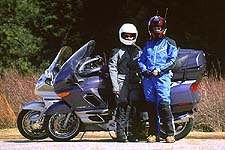










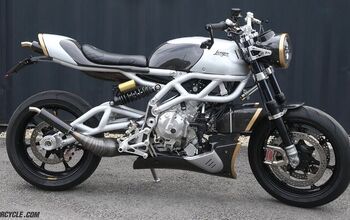
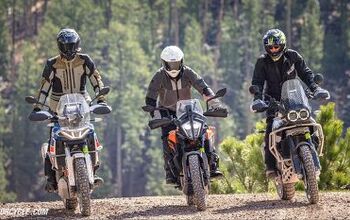

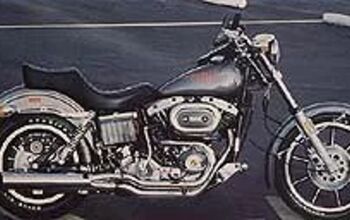
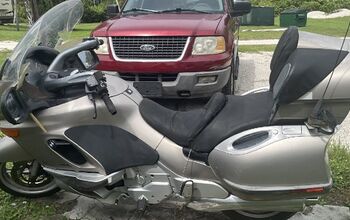













Comments
Join the conversation